Airsofters often take a beating in the “real world.” Often this is a just and well-deserved mockery. Other times it’s unwarranted, unnecessarily critical and even inaccurate. Several of us have used airsoft weaponry for training for years now, finding it to be an excellent tool (and often the only thing available for immediate feedback – like when Range Control decides that Simunitions or marker cartridges can’t be used because they “leave marks on the walls”). We think airsoft is one of the most unused, least appreciated and unnecessarily reviled training tools available to today’s shooter. Today’s guest writer is going to dissect the use of airsoft in training; you’ll want to avail yourself of his perceptively percipient perspective (grunts: percipience). If you’re a MILSIM hater, at least do us the courtesy of reading the article before decrying its contents – especially the part about force on force training. Mad Duo
Using Airsoft For Training
By Jeff Takeda; Photos and Video by Alex Ko
I first encountered Airsoft guns back in 1990; I was a 19-year-old Marine Rifleman on a six-month unit deployment to Camp Schawb, Okinawa. Several buddies and I found some gas powered Tokyo Marui Airsoft pistols in a shop outside Kadena Air Force base. We bought an assortment of Airsoft 1911s and Desert Eagles. The guns were so cool; they looked real, shot hard, and actually recoiled. I became obsessed with Airsoft. Since that time I’ve turned into an admitted Airsoft Geek, keeping up with the latest Airsoft gun technology and related products.
In 2002 I was working as a police officer in Southern California. My small agency’s regional SWAT team needed to conduct Force on Force training, but had no equipment for it. We had a whopping $500 available for training gear. We could barely afford one Simunitions kit for an AR, let alone the recurring cost of the ammunition. Being an Airsoft Geek, I advocated for using Airsoft and it was approved just based on the low cost. We purchased some Beretta M9 replicas and were able to conduct regular Force On Force training. The Airsoft guns were not just affordable but proved to be effective training tools.
Airsoft technology has many benefits and advantages beyond cost savings. It is safer than other Non-Lethal Ammunition systems, since Airsoft guns are not real firearms and cannot fire live ammunition. Airsoft is versatile; there are Airsoft replicas available of nearly every type of firearm in use by law enforcement agencies and military units. Further, Airsoft can be used nearly anywhere; in schools, office buildings, and other settings where paintballs or other Non-Lethal projectiles could cause damage or make a mess. Airsoft is effective; Airsoft guns are consistently point of aim, point of impact accurate out to 33 yards. Compare this to Simunitions which has a drop of 8 inches at 30 yards for their 5.56mm cartridge and a drop of 6 inches at 25 feet for their .38 and 9mm cartridges.
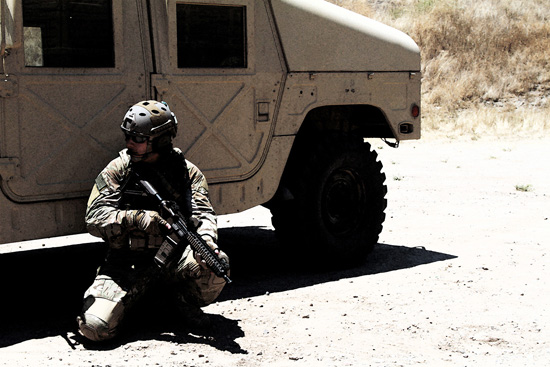
Reiterating one of its most bureaucractically appealing points; Airsoft is inexpensive. A complete Airsoft rifle runs between $200 to $300, and a pistol around $150. Airsoft BBs cost about $15 for 3000 rounds. Airsoft guns can also do “double duty” and fill the role of non-firing solid plastic training guns such as Red Guns. So which type of Airsoft technology works best for training? What are the limitations of the platform? How do you get the maximum training benefit from Airsoft?
The purpose of this article is to provide information regarding the types of Airsoft guns best suited for training. Further we will specifically discuss using Airsoft for Marksmanship Training and Force on Force scenarios as well as getting the most out of the platform.
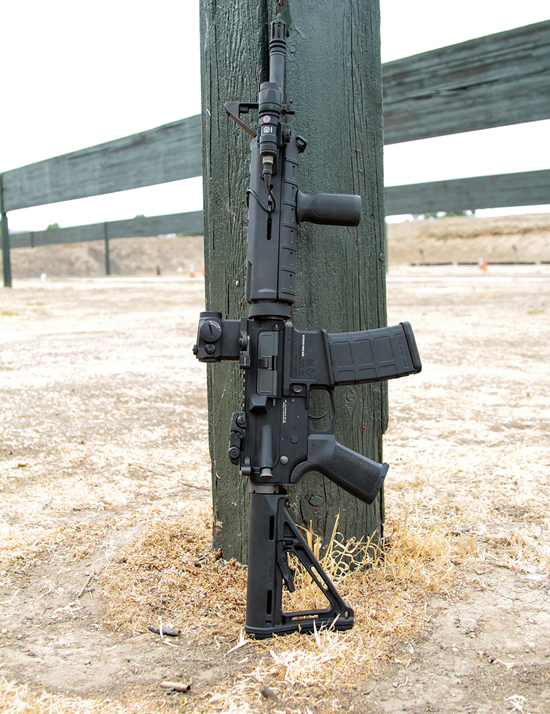
Types of Airsoft Guns
There are two basic types of Airsoft guns best suited for training, Gas Blow Back (GBB) guns and Automatic Electric Guns (AEGs.) Let’s take a look at Gas Blow Backs first.
Gas Blow Back (GBB) airsoft guns utilize a compressed gas to propel the BB. The gas and BBs are contained in the Airsoft gun magazine. The gas used is commonly referred to as “Green Gas” and it is available at airsoft retailers. Another option is to just use propane. A special airsoft propane adaptor nozzle can be purchased, which screws onto to the top of a standard 16.4-ounce camping stove cylinder. These adaptors also contain a reservoir to add silicone oil which keeps the propane from drying out the seals in the airsoft gun and magazine.
Both pistol and rifle versions of GBB guns are available. One of the greatest advantages of GBB guns is their method of operation; they function similarly to real firearms. The gas allows the slide of the pistol or the bolt of the rifle to actually reciprocate with felt recoil. The slide or bolt will lock open on the last round fired. The manual of arms for loading and clearing malfunctions is nearly identical to the actual firearm.
An example of a GBB is the PTS (Professional Training and Simulation) MKM rifle. A quick caveat here, I am a consultant for PTS, and we produce the MKM as well as the later mentioned RM4 ERG. I only mention these products here because they are both good examples of the current technology. There are others you can certainly locate and evaluate with simple due diligence.
There are some disadvantages to GBBs. The Achilles’ heel of the GBB system is the magazine, whcih contains both the gas and BBs. The magazines are heavy and can be easily damaged often permanently if dropped on a hard surface. Secondly, the performance of GBBs suffers in cold weather. I have seen GBBs malfunction due to cold at only 50 degrees Fahrenheit. That said, I have seen some GBBs function in 30 degrees Fahrenheit. Either way cold weather is not conducive to GBB use. Of course, if you are training indoors this may not be an issue at all.
The second type of airsoft gun suitable for training is referred to as an Automatic Electric Gun or AEG. An AEG utilizes a rechargeable battery to power a piston and spring mechanism to propel the BB. Rifles are the most common type. The big advantage here is durability and reliability. This is why you see the majority of airsoft hobbyists using AEGs for play and competition. AEGs are more robust and reliable than Gas Blow Backs. Another advantage of an AEG is low cost. You can find “Sportline” or “Economy” AEGs that are very reliable for as low as $150.
The main disadvantages of AEGs relate to non-realistic function. The first disadvantage of note is the trigger mechanism. The trigger does not break; it is merely a switch completing a circuit and is not well suited for realistic marksmanship training. Secondly a standard AEG will keep cycling even when the magazine is empty, which does not lend itself to realistic weapons manipulation training. And finally there is no felt recoil on a standard AEG.
That said there are AEGs that have special features which bring them closer to realistic function. Two examples of these guns are the RM4 Electric Recoil Gun (ERG) by PTS and
the Systema Professional Training Weapon (PTW).
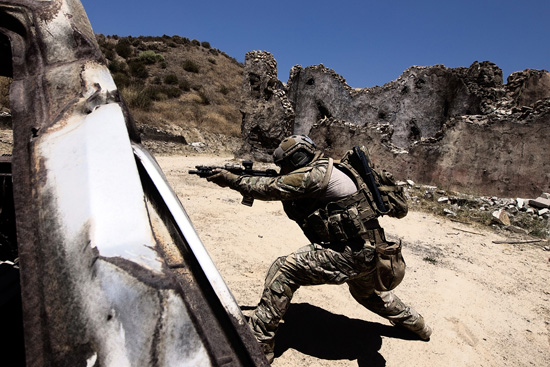
The RM4 ERG is a new class of electric gun and in my opinion is a good option over a standard AEG. The RM4 has a “recoil engine” that simulates recoil. Further the RM4 also has a “last shot stop” feature, which causes the gun to stop firing when the last BB is expended from the magazine. The user must then insert a fresh magazine and hit the simulated bolt release to allow the gun to start firing again. The RM4 is also representative of the technology becoming less expensive. The RM4 with all these features retails at about $380.
Another similar electric gun is the Systema PTW which has all these same features but without the recoil system. The PTW is a great system, however AT $1,000+ per rifle it is cost prohibitive. It is also not widely available.
Finally, there are a couple of features common to both GBBs and AEGs. Both systems are 1:1 scale replicas of the real firearm. They are usually compatible with your existing slings, holsters, and load bearing equipment. The magazines for both systems will fit in mag pouches on your duty belt, chest rig, etc.
Airsoft guns, either GBBs or AEGs, can also do “double duty” and replace solid plastic non-firing training guns like Red Guns. No need to buy two different products. Airsoft guns work well in a classroom environment for demonstrations. They are also great to use for training police Explorers or Cadets, or anytime where real firearms are not an option.
Airsoft For Marksmanship Training
Usually when we talk about Non-Lethal Ammunition devices whether it is Airsoft, Simunitions, UTM, or paintball we think of using it only for Force on Force training. But these devices can be used for marksmanship training. Airsoft is more viable in the marksmanship training role. Simunitions and UTM are cost prohibitive with the ammunition costing between 50 cents and one dollar a round. Paintball guns are less realistic than Airsoft and of course you have the mess to deal with. Airsoft offers the cost savings and the versatility. You can set up an Airsoft range or shoot house nearly anywhere. Now let’s take a look at some guidelines and considerations for using Airsoft in the marksmanship training role.
Airsoft guns shoot a 6mm spherical plastic pellet through a smooth bore barrel at velocities ranging from 300 to 500 feet per second. The maximum effective range of an airsoft rifle averages about 33 yards. Airsoft guns can reliably and consistently shoot point of aim, point of impact at this range in good weather conditions, meaning little or no wind.
There is a mechanism called the Hop Up on Airsoft guns and it is crucial to establishing a consistent trajectory. The Hop Up unit is a mechanism attached to the barrel that creates back-spin on the BB as it leaves the chamber and enters the barrel. The back spin counter acts the effects of gravity on the BB giving it lift. This allows the BB to travel farther and straighter. Hop Up Units are adjustable allowing the user to adjust the unit so that the BB will fly as straight as possible for as long as possible. So for example, if you shoot your Airsoft gun and the BB travels straight for just a few feet and suddenly curves down you have too little “hop”. Adjust the Hop Up to add more “hop” until the trajectory is straighter and flatter for as far as possible, usually about 30 yards. Conversely, if you shoot your Airsoft gun and the BB suddenly flies up you have too much “hop” and need to dial the Hop Up down.
However, Hop Up can create a problem if the Airsoft gun is shot sideways. If shot sideways (such as when shooting from underneath a vehicle or when wearing a gas mask) the Hop Up will cause the BB to travel to the left or right, depending on which way you have the gun tilted. However at closer ranges out to about 7 yards this “Hop Up Affect” is usually not an issue.
The type and weight of the BB you use matters also. Yes, there are actually different types of Airsoft BBs. First, only use high quality BBs found at Airsoft retailers. Using the right weight BB is also important in creating a consistent trajectory. You do not want to use a BB lighter than .20 grams and not much heavier than .30 grams. I have had very good results with .28 gram BBs.
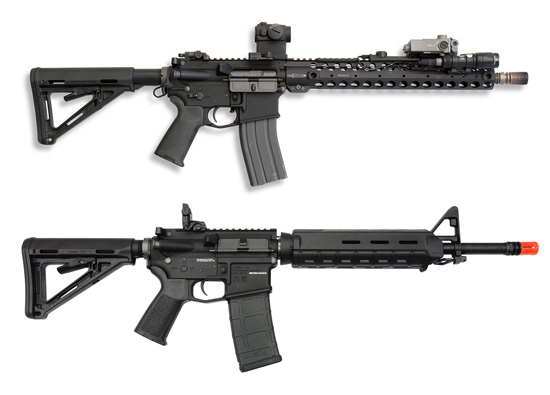
Now let’s talk about some ways to maximize the effectiveness of Airsoft for Marksmanship Training. We mentioned the limited range (in regards to real firearms) of the airsoft gun, the effect of the Hop Up, and the susceptibility of the BB to the wind. A very simple way to mitigate this issue, for marksmanship training, is to simply shoot at 7 yards and closer and scale the targets down in size.
At 7 yards and closer the trajectory of the BB will stay flat. Also, the Hop-Up unit will not affect trajectory so that firing techniques requiring a cant on the gun can be practiced. Of course shooting 7-yards and closer may make shooting at full size targets not too challenging, so scale the targets down in size. Scaling targets down not only helps to make your training more challenging it also allows you to train in areas where you have limited space such as your garage. At my previous agency I used to set up an Airsoft range in our sally port.
There are scaled down Airsoft training targets used for ISPC and other shooting sports. The targets are scaled to visually appear the same size as the real target at true distance. For example one of these scaled down IPSC size targets placed at 9 feet presents the same sight picture perspective as a full sized IPSC target placed at 23 feet approximately.
Here is a video put together by my partner at PTS, Alex Ko. The video shows our buddies Chris Naganuma, Brad Blackmon, Mike, in addition to Alex and myself using Airsoft for training. Chris is former US Army and a 3-Gun shooter for Blackrain Ordnance. Brad is former USMC and also a 3-Gun competitor for S3F Solutions. Mike is one of our friends and a squared away shooter. In the video we are using GBB Airsoft rifles and pistol with scaled metal knock down targets and full size IPSC style targets with knock down A-Zones.
IPSC competitors, especially those in countries where they don’t have regular access to real guns have been using Airsoft for years to practice. In fact, there is an IPSC sanctioned Airsoft shooting league in Hong Kong called Action Air. During one of my trips to Hong Kong, I visited a local Action Air field called HK Shooters. I was amazed to see the elaborate set up there with barricades, scaled cardboard IPSC targets, scaled metal poppers, timers, the whole nine yards.
Something else to note when using Airsoft, just like paintball, you can actually see the projectiles in flight. Trainees may have a tendency to start watching the flight of the BBs instead of the weapon’s sights. To prevent this, use black or other dark colored BBs. They won’t be able to visually track them.
So in the end, how effective is Airsoft as a marksmanship training tool? For myself, I have used Airsoft over the years to h
one my marksmanship skills. I recently used a Gas Blow Back SIG P226 replica to train up for my department’s SWAT selection process. Our team requires candidates to qualify with the SIG P220, which is what the team carries. I normally carry a Glock 21, so I broke out my SIG replica and practiced in my garage. During the range portion of selection, I nearly shot a perfect score on the qualification course. But don’t take it from me. Tatsuya Sakai, a Japanese IPSC shooter, trained with Airsoft exclusively for a year before competing in the 2004 Steel Challenge. He trained with a real gun only a month before the match and ended up winning the entire Steel Challenge that year.
Airsoft For Force on Force Training
Airsoft is an excellent tool for Force on Force Training. It allows training in nearly any environment without causing permanent damage or making a mess. It is especially well suited for training environments where real firearms are not permitted in a training scenario such as in jail or prison facilities. The versatility of Airsoft allows trainers to set up training areas quickly and virtually anywhere. This facilitates more training evolutions and more persons trained.
As an example, here’s one Airsoft training session we set up in the sally port at my police department. I had a patrol vehicle and a “bad guy car” set up as if on a traffic stop. There were several small metal knock down Airsoft targets set up on the bad guy car. Each one was painted red, blue, or white and placed at different locations on the bad guy vehicle.
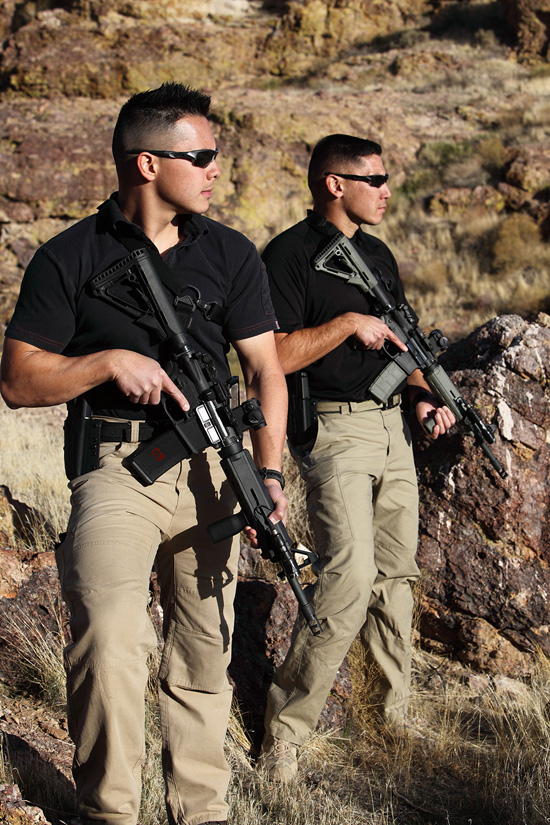
The trainee officer was instructed to either approach the vehicle as if on a “routine stop” or to stand back at his vehicle and fill out a fake traffic citation. At a time unknown to the trainee, I fired several blank rounds into the air, simulating that the trainee was taking fire from the bad guy vehicle. I also yelled out a color, red, blue, or white. The trainee would then need to seek cover and return fire on the correct target, until the threat went down. The officers got to practice shooting while getting in and out of a patrol vehicle and had to apply the marksmanship fundamentals, as these target were small and at about 7 yards. Now this was not Force on Force training, but I could have easily swapped out the targets for role players.
The ability to set this up quickly and right in the sally port at the station, allowed me to cycle an entire on-duty watch of patrol officers through the training in just a couple of hours. The officers simply parked outside the sally port, secured their weapons in their vehicles, did a couple of runs through the scenario, and went 10-8. It was very fast and efficient, and more importantly it was good training. No prolonged set up and no long drive time to our out of town range. If some major call went down, the officer doing the training could quickly gun up and respond from the station.
Here is a video of several of us doing some “live fire shoot house” type training and Force On Force with live role players using both Airsoft GBB rifles and pistols.
Airsoft is a great tool, but it is not without limitation. One of the issues with Airsoft guns, especially in the Force On Force role for Active Shooter training, is the lack of a realistic report. There is no loud bang. Active Shooter response protocol requires officers to respond directly to the sound of the gunfire. Airsoft guns are simply not loud enough to replicate this in training. But Simunitions and UTMs are usually not loud enough either. One way to overcome this is to use a blank firing gun in addition to Airsoft. In the past, I have had the bad guy shoot a blank firing gun at the beginning of the scenario, until the trainees locate him. He then engages the trainees with Airsoft to complete the scenario.
Another consideration to be aware of is the “lack of pain” issue at distance. Don’t get me wrong getting hit with an Airsoft at close range hurts. But when you get out to 30 yards the BBs don’t have much of a sting. Often times a trainee will not feel the BB at that distance, but they can usually hear the BB impacting on them.
One more consideration when using Airsoft is what I call the “Airsoft Stigma.” A lot of people view Airsoft guns as toys and that attitude can carry over into how they train with them. Unfortunately, I’ve seen more than one training scenario devolve into a “BB gun war”. Not to mention, someone always decides to shoot someone in the ass during a break, which turns into an Airsoft free for all.
Granted, most of this comes down to the discipline of the individuals that are training. But there things you can do as training staff to lessen the “Airsoft Stigma” and induce more professional behavior. Go over the Four Firearms Safety Rules with trainees before training begins. Reinforce that unsafe weapons handling skills, even with training guns, can build “training scars” and have dire effects on the street. Trainees should realize that these Airsoft guns are tools used to help them survive a lethal force situation, and not to build bad habits.
A quick note on Airsoft gun quality, as I could write another article just on that topic. The old adage, “You get what you pay for” holds true here. There’s a lot of junk out there, cheap junk. Do some research on the brand and model before you buy. Your local airsoft retailer can give you the scoop on what brands are most reliable.
Over the past 10 years, Airsoft has gained popularity across the globe. As a result Airsoft guns have become more reliable, durable, realistic, and better suited for training. The guns are affordable and available and their use is sustainable with the low cost of BBs. In a world of shrinking training budgets, rising ammunition expense, and ammunition scarcity, Airsoft is an inexpensive and safe way to train. Most importantly, it is has proven to be an effective tool for conducting Force on Force and supplemental marksmanship training.
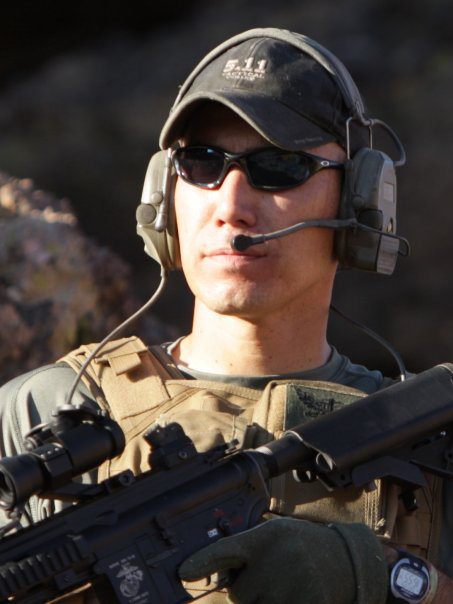 About the author: Jeff Takeda is a former U.S. Marine and is currently employed as a police officer in Southern California. He has a varied background in both security and law enforcement operations. As a Marine, Jeff served as an infantry squad leader and as a Marine Corps Security Forces member. In addition, he served in the U.S. Army National Guard as a military policeman in the state of California. In the private sector, Jeff was part of an overseas security team, operating in the former Soviet Republic of Kazakhstan. Jeff has been a sworn police officer for over 12 years and has served as a detective, field-training officer, and firearms instructor. He currently works uniformed patrol and is a member of his department’s SWAT team. Jeff is also a military / law enforcement training consultant for Professional Training And Simulation (PTS), a company that produces high quality Airsoft guns and accessories for training purposes.
About the author: Jeff Takeda is a former U.S. Marine and is currently employed as a police officer in Southern California. He has a varied background in both security and law enforcement operations. As a Marine, Jeff served as an infantry squad leader and as a Marine Corps Security Forces member. In addition, he served in the U.S. Army National Guard as a military policeman in the state of California. In the private sector, Jeff was part of an overseas security team, operating in the former Soviet Republic of Kazakhstan. Jeff has been a sworn police officer for over 12 years and has served as a detective, field-training officer, and firearms instructor. He currently works uniformed patrol and is a member of his department’s SWAT team. Jeff is also a military / law enforcement training consultant for Professional Training And Simulation (PTS), a company that produces high quality Airsoft guns and accessories for training purposes.
Alex Ko is a civilian firearms shooting enthusiast and team member of the PTS Business Development and Marketing Departments. He discovered
airsoft at an early age and has pursued the hobby for the past 30+ years. In 2005, after a lengthy hiatus, Alex rediscovered his appreciation for real steel firearms shooting. He has since attended firearms training courses taught by many of the industry’s finest instructors (Vickers, Pannone, Hackathorn, McNamara, Defoor, TigerSwan, RedBack One, Magpul Dynamics, Costa Ludus, Falcon Operations Group, TFTT, et al. Alex spends much of his free time furthering his education as a shooting enthusiast and has begun to participate in competitive shooting.






Thank you for sharing your info. I reallly appreciate your efforts and I will be waiting for your further write ups thank you once again.